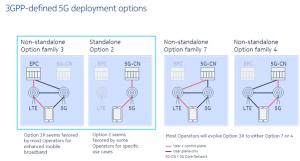How the core network will underpin 5G success

Ester Navarro of Nokia
5G has long been the hot topic for discussion within the tech community. For many, the immediate association is that 5G, being a mobile technology, is defined by the radio network. But, says Ester Navarro, head of Telco Cloud product marketing at Nokia, we mustn’t forget something equally important – the core network.
The core network will be central to achieving the exciting capabilities and new services of 5G many in the industry are eulogising about. One new capability will be end-to-end network slicing. Dedicated slices of the network will use specific policies or service level agreements to allow operators to offer a wide range of services with a guaranteed experience.
That’s one among a host of possible benefits, but, for this potential to be truly unlocked, the 5G core needs to be built with a cloud-native design that’s highly programmable, scalable, adaptable and appropriately resilient. The 5G core has been designed to embrace cloud technologies and architectures.
The 5G core also builds upon the 4G core’s software and architecture disaggregation capabilities known as control and user plane separation (CUPS), allowing for a distributed architecture with placement of core functions closer to the edge to deliver increased bandwidth and sub millisecond latency. The 5G core will use cloud concepts such as microservices and container technologies with open, programmable Application Programme Interfaces (APIs) that yield a more flexible, scalable and efficient multi-vendor network.
This sounds like a lot, but the good news is that standards work for the 5G core has already met significant milestones in terms of maturity.
New architecture defined
In July, the 3rd Generation Partnership Project 3GPP Release 15 defined a new 5G core architecture that provides a multi-access anchor point to deliver seamless service over licensed and unlicensed wireless, fixed or converged networks. This new 5G core adopts cloud-based characteristics including a Service-Based Architecture that breaks away from existing monolithic implementations by enabling network functions to discover and interact with each other. Additional core features and functionality will continue to evolve.
Commercial Service Providers (CSPs) have several deployment options for 5G, even with the ability to keep using their existing Evolved Packet Core (EPC). 3GPP has defined a number of standards-based options for 5G deployment. The first option is non-standalone (NSA) where the existing 4G EPC architecture supports the 4G and new 5G radios. The second option is standalone (SA) where only the 5G (3GPP Release 15 and beyond) core supports the new 5G and enhanced 4G radios (eLTE).

The crux of the matter is that CSPs only stand to be able to offer 5G’s full set of new use cases and services by deploying an agile cloud-native 5G core.
5G to bring new joined-up services
More and more, 5G is being recognised for far more than just its potential to deliver faster speeds and higher capacity for video and its list of use cases is extending way beyond that of just broadband services for CSPs. The reality is setting in that 5G will enable a multitude of organisations, including enterprises, to offer a variety of joined-up services across a range of verticals, accessible from any device over any connectivity medium.
Making the most of 5G will not just be dependent on radio, but on the flexible and scalable processing power provided by a centralised and distributed cloud-native core network architecture. This 5G core will create a global connected nervous system and form the basis for a connected-world.
Together with 5G radios, this technology will enable ultra-reliable low-latency communications, massive Internet of Things (IoT) and machine communications, enhanced mobile broadband and productivity through an adaptable, programmable network. All of which has the potential to transform society and fuel industrial revolution.
With the right end-to-end solutions and determination to make it happen, 5G can work for everyone. An it’s happening right now. The Telia company in the Nordics and Baltics are deploying a cloud-native core to deliver enhanced mobile broadband and manage their mobile network data demand. T-Mobile US are also poised to commence the deployment of a nationwide 5G network, delivering faster speeds for on-demand augmented and virtual reality and massive connectivity for devices and sensors.
The author of this blog is Ester Navarro, head of Telco Cloud Product Marketing at Nokia
Comment on this article below or via Twitter @IoTGN
